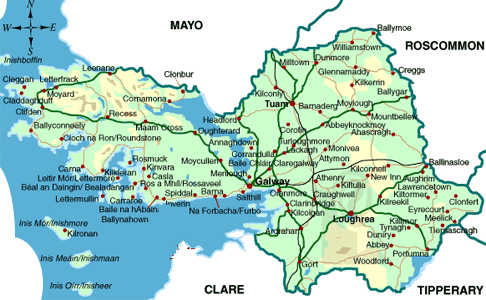Images of Galway |
|
(click images to enlarge) |
| Galway is the main city of the Western Ireland, term used to refer to the region that lies west of the River Shannon and which is part of the old province of Connaught. |  |
Galway County spreads around Galway city, with a 50 kilometers-long lake northwards - the Lough Corrib -, the mountainous and desolate Connemara region to the west, and a large region of plains on the east which borders on Counties Mayo, Roscommon, Tipperary and Clare |
The West remained until the late 18th century - excepted for the walled town of Galway itself - out of foreign influences that had Europeanized the rest of Ireland. This explains why Galway today is the Capital of the "Gaelthacht" (Irish-speaking), and the most typically Irish part of the country. Thanks to the lure of its spectacular scenery to visitors, Galway and its region are now developing rapidly. Galway spreads on both rives of the River Corrib, a 2 miles short river between lake Lough Corrib and the sea. |
||||||||
View of Claddagh port in Galway |
||||||||
![]()
The origin of Galway is Claddagh, a small Irish fishing port and village. The Anglo-Normans were won over by this site sheltered in a deep bay, midway of the Irish West coast. From the late 12th century, the Burke clan - from Norman knight William de Burgo - built here, on the east side of River Corrib, the town of Galway. |
|
|||||||
|
||||||||
The "Spanish door" |
Typical fishing boats ("Galway Hookers") |
|||||||
![]()
From the17th century on, Galway will decline, probably due to its too faithful attachment to the Royal Family of England, after Cromwell in 1652 and Guillaume d'Orange in 1691 besieged the town. |
The recent Catholic Cathedral was built in 1957, "as an ancient one", in neogothic style, in place of old city jail. The stone used is a local stone called "black marble of Galway" (in fact a black Galway limestone).
It also has magnificent stained glass windows and "Connemara marble" floors
.
|
|||||||
|
||||||||
The new Catholic Cathedral (built in 1957) |
Its modern stain-glass windows |
|||||||
![]()
Sight on River Corrib from "Salmon Weir Bridge", which leads to the Cathedral. The weir has a ladder for salmons |
||||||||
|
||||||||
Fisherman before the salmon weir |
Cathedral seen from the distance |
|||||||
![]()
Lynch Castle was owned for several centuries by one of the 14 tribes of Galway. Today it is a bank |
Small street of Galway leading to Claddagh Port |
|||||||
|
||||||||
Lynch's castle |
Historical center of Galway, |
|||||||
![]()
Beautiful Victorian building in the pedestrian precinct of Galway |
Nice colors ... |
|||||||
|
||||||||
Galway - Victorian building |
Street in the commercial area |
|||||||
![]()
On the opposite shores of Galway bay, at Kinvarra, this castle was built in 1520 by the successors of Gaire, king of Connaught in the 7th century It is still inhabited today and is also used for "Medieval Banquets" |
Kinvarra's small port |
|||||||
|
||||||||
Dungaire Castle at Kinvarra |
The small port at Kinvarra |
|||||||
![]()
Ireland is the first touristic country for golf players, who come to play from all over the world |
Many links are located in seaside resorts, on windy sandhills that are difficult to play |
|||||||
|
||||||||
Golf link along River Corrib |
Golf links on the south coast of Connemara, west of Galway |
|||||||
![]()
| Copyright © WEB-SY - August 2004 | Editing and photographs : Marc GERONDEAU |
Email : mgerondeau@web-sy.fr |